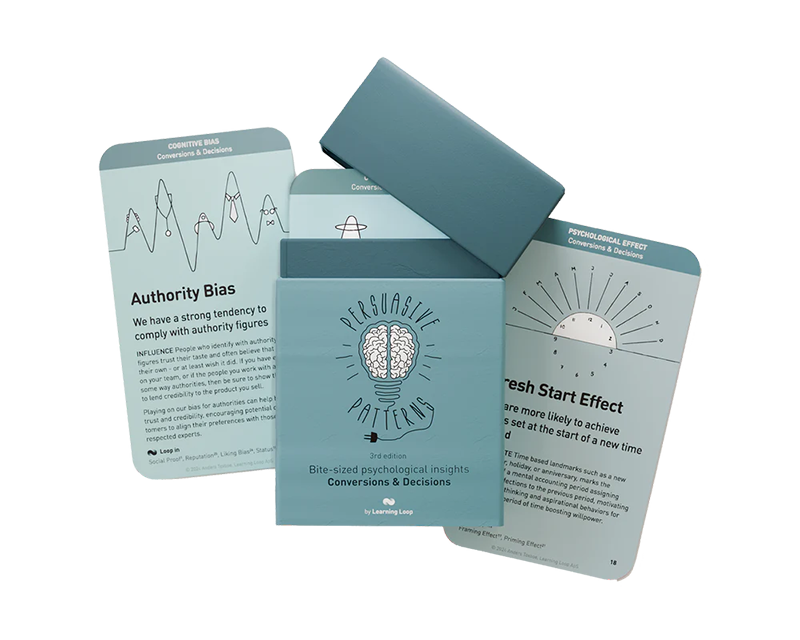Persuasive Patterns: Facilitation
Choice Closure
We are more satisfied with decisions when we engage in physical acts of closure
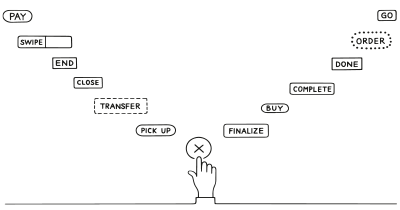
Choice Closure refers to the psychological principle that people experience greater satisfaction with decisions when they engage in a physical act that signifies the conclusion of the choice process.
Choice Closure thrives on the human desire for a definitive ending to the decision-making process. Consider the act of purchasing a new book at a physical store. You’ve browsed the shelves, compared options, and finally settled on the perfect one. The act of walking to the register, placing the book on the counter, and completing the transaction with a swipe of your card or a handful of cash provides a clear sense of closure. This final action signifies the end of your decision journey and leaves you feeling satisfied with your choice.
The same principle translates seamlessly to the digital world. Imagine searching for a new pair of headphones online. You’ve meticulously combed through reviews, compared features, and narrowed down your selection. The moment you click the “Add to Cart” button serves as your digital act of closure. This definitive action signifies the end of your search and instills a sense of accomplishment in having made a choice. The positive feelings associated with Choice Closure can even influence you to proceed further, perhaps finalizing the purchase or continuing to explore complementary products.
By incorporating clear and definitive actions to mark the end of the decision process, designers can create a more satisfying user journey and potentially influence user behavior in a positive way.
The study
In their 2013 study, Gu, Botti, and Faro explored the psychological impact of physical acts of closure on decision satisfaction. The researchers conducted experiments where participants were asked to make choices and then either seal their decisions in an envelope or leave them unsealed. The findings revealed that those who physically sealed their choices exhibited a higher level of satisfaction with their decisions and were significantly less likely to change their minds later.
This study underscores the importance of physical closure in enhancing the permanence and satisfaction associated with decision-making processes. The implications of these results suggest that tangible acts of closure can serve as powerful tools in reinforcing commitment to choices, which can be particularly valuable in settings that require high stake decisions or in marketing strategies aiming to solidify consumer choices.
Gu, Y., Botti, S., & Faro, D. (2013). Turning the page: The impact of choice closure on satisfaction. Journal of Consumer Research, 39(6), 1466-1482.
Executing a physical act signaling the completion of a decision-making process significantly boosts satisfaction with those decisions.
Cognitive dissonance theory, introduced by Leon Festinger, posits that inconsistencies among beliefs, or between beliefs and actions, create psychological discomfort. Individuals are naturally driven to reduce this discomfort. An act of closure, such as sealing an envelope or closing a box after a decision, helps align one’s actions with their decisions, effectively reducing dissonance and enhancing satisfaction. This alignment reinforces the decision made, stabilizing the individual’s internal state and increasing contentment with the choice.
Building on this, Arie Kruglanski’s need for closure theory provides further insight. It argues that individuals desire definitive answers and have an aversion to ambiguity. A physical act of closure marks the end of deliberation, thereby diminishing uncertainty and augmenting satisfaction with the decision. This need for closure is a fundamental aspect of human psychology, reflecting a broader desire for clarity and resolution in everyday life.
Additionally, Choice Closure taps into the principle of cognitive closure. This concept suggests that humans inherently seek clarity, certainty, and completion in their decisions. An open-ended decision process can leave room for doubts and a sense of incompleteness. By providing a definitive physical action that signifies the conclusion of the decision process, Choice Closure addresses these issues, leading to a more resolved and satisfying decision-making experience.
Several psychological mechanisms are activated through Choice Closure, including reduced cognitive load, confirmation bias, and a sense of accomplishment. When a decision process culminates in a clear act of closure, it lowers cognitive load and confirms the decision through subsequent affirmation of the choice, solidifying the individual’s commitment and satisfaction. Moreover, completing a task, even a minor one like clicking a button, can elicit a sense of accomplishment, further enhancing satisfaction with the decision.
Pre-committing as a form of decision closure
The seminal study by Katherine Milkman, Todd Rogers, and Max Bazerman on choice closure focuses on the impact of pre-commitment strategies in decision-making and satisfaction. In their experiment, Milkman et al. explored how committing in advance to one’s choices could affect later satisfaction with those choices. Participants in the study were asked to make selections from a group of DVDs, some of which were categorized as “high-brow” (intellectually stimulating) and others as “low-brow” (purely entertaining). After making their selections, some participants were asked to “pre-commit” to their choices by ticking a checkbox indicating they would not want to change their decision in the future.
The study found that participants who checked a box to pre-commit to their DVD choices were less likely to experience regret or to wish they had chosen differently when evaluated at a later date.
Furthermore, those who pre-committed reported higher satisfaction rates with their choices. This effect was particularly pronounced when the decisions involved potential trade-offs between what participants thought they should choose (high-brow DVDs) and what they wanted to choose (low-brow DVDs).
Milkman, K. L., Rogers, T., & Bazerman, M. H. (2010). Highbrow films gather dust: Time-inconsistent preferences and online DVD rentals. Management Science, 55(6), 1047-1059.
Research underpinning Choice Closure has demonstrated that physical experiences help us grasp abstract concepts. For instance, the simple act of closing a laptop at the end of the day can evoke a rush of calmness, underscoring the psychological relief that comes with closure. Similarly, experiments, such as those involving menu choices in restaurants, have shown that people who engage in a physical act of closure after making a decision report higher satisfaction compared to those who do not perform such an act.
Choice Closure is particularly effective in scenarios involving numerous options, such as in supermarkets. Here, the paradox of choice might otherwise lead to post-decision regret. By facilitating closure with a chosen option, this psychological pattern helps minimize regret and boosts consumer satisfaction. This has important implications for retail strategies, suggesting that integrating simple acts of closure into customer decision processes can lead to more positive experiences and customer loyalty.
Designing products using Choice Closure
While Choice Closure signifies the end of the decision process, it can also be an opportunity to solidify the user’s choice. A simple confirmation message highlighting the chosen option or its benefits can provide reassurance and further enhance user satisfaction. This message acts as a positive reinforcement, reducing any lingering doubts and promoting a sense of confidence in the decision made.
The principles of Choice Closure extend beyond the digital world and can be applied to physical products as well. Consider product packaging – the act of opening and closing the package can be a deliberate part of the user experience. A satisfying click when a product is secured or a color-changing seal that confirms proper closure can provide a sense of completion and user satisfaction.
Software applications can leverage Choice Closure by designing workflows that culminate in a summary screen. This screen details the actions taken and their outcomes, providing a sense of closure while setting clear expectations – a crucial element for user satisfaction. Educational and productivity software can benefit from incorporating completion markers like checkmarks, progress bars, or page turns after each completed task or module. These visual cues signal the end of a section and provide users with a sense of accomplishment, reinforcing the Choice Closure principle.
When implementing Choice Closure, it’s vital to ensure that the physical or digital act of closure is perceived unmistakably as an endpoint. Clear and direct messaging, straightforward visual indicators, and consistent behavior across similar interactions are all essential in avoiding any new ambiguity. By following these guidelines, designers can create a seamless user experience that guides users confidently through the decision process and fosters a sense of satisfaction with their choices.
Ethical recommendations
Unethical use of Choice Closure can manipulate users or pressure them into decisions that don’t align with their best interests.
Examples include excessively deploying Scarcity tactics like fake countdowns or limited-availability claims alongside prominent “Buy Now” buttons can pressure users into impulsive purchases they might later regret. Or obscuring essential details about a product or service while highlighting the “Add to Cart” button hinders informed decision-making. This can lead to user dissatisfaction and erode trust.
To mitigate such misuse, consider the following best practices:
- Be transparent
Be upfront about product details, pricing, and availability. Scarcity tactics, if used, should be genuine and time-limited. - Facilitate informed decisions
Provide users with all the information they need to make informed choices. Don’t obscure crucial details behind a prominent “Buy Now” button. - Respect user autonomy
Focus on guiding users through the decision process, not pressuring them. The act of closure, like a clear “Confirm Purchase” button, should signify a user’s deliberate choice. - Prioritize user satisfaction
Ultimately, Choice Closure should enhance the user experience, not manipulate users. Strive to create a sense of accomplishment and satisfaction with the completed decision.
Real life Choice Closure examples
Online banking
Many mobile banking apps utilize Choice Closure when users transfer funds. A confirmation screen displaying the sender, receiver, and amount, followed by a satisfying animation upon successful transfer, provides a clear endpoint to the transaction.
Software installation
Software installation wizards often break down the process into distinct steps. Reaching the final step and clicking “Install” serves as a physical act of closure, signifying the completion of the installation process.
Canceling subscriptions
Subscription services often employ a multi-step cancellation process. Incorporating clear confirmation steps at the very end, with options to review the chosen plan or benefits, provides a sense of closure and reduces the likelihood of accidental cancellations.
Trigger Questions
- Do our users have a clear and definitive action to signify the end of their decision process?
- For complex decisions, do we provide progress indicators to build a sense of nearing completion?
- Do our confirmation messages reassure users about their choices and highlight the benefits?
- Is the act of closure clear and unambiguous, or does it introduce any new confusion?
- Is our use of Choice Closure consistent across different user interactions within the product?
Pairings
Choice Closure + Scarcity Bias
Scarcity marketing highlights limited availability to create a sense of urgency. Pairing this with Choice Closure can be particularly effective. For instance, an e-commerce store displaying “Only 2 Left in Stock” next to an “Add to Cart” button creates a sense of urgency and a quick resolution that motivates users to complete the purchase before the opportunity disappears.

We are more satisfied with decisions when we engage in physical acts of closure

We value something more when it is in short supply
Choice Closure + Loss Aversion
Humans are naturally more motivated to avoid losses than acquire gains. Combining Loss Aversion with Choice Closure can incentivize users to take action. For example, a fitness app might display a message like “Don’t lose your progress! Complete your workout today” near a clear “Start Workout” button. This taps into the fear of losing progress, prompting users to take the desired action.

We are more satisfied with decisions when we engage in physical acts of closure
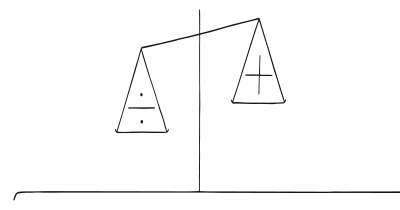
Our fear of losing motivates us more than the prospect of gaining
Choice Closure + Social Proof + Feedback Loops
After a purchase, allow users to submit reviews or ratings alongside a clear “Submit Review” button. This action reinforces their decision and creates a feedback loop that can influence future users.

We are more satisfied with decisions when we engage in physical acts of closure

We assume the actions of others in new or unfamiliar situations
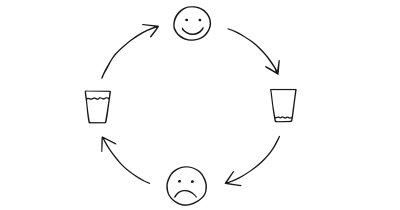
We are influenced by information that provides clarity on our actions
Choice Closure + Commitment & Consistency
Following a purchase of a subscription service, offer a clear “Start Free Trial” button. This leverages Commitment & Consistency – users are more likely to stick with their initial decision. Send gentle reminder emails before the trial ends with a clear “Subscribe Now” button to maintain user engagement.

We are more satisfied with decisions when we engage in physical acts of closure
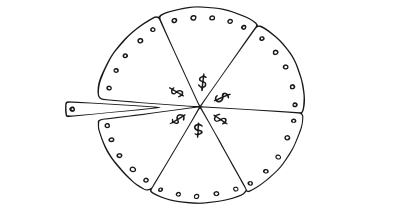
We want to appear consistent with our stated beliefs and prior actions
Choice Closure + Framing Effect + Goal-Gradient Effect
Upon purchase completion, display a confirmation message framed positively (e.g., “You’re on your way to a healthier lifestyle!” - Framing Effect). Combine this with a progress bar showcasing upcoming delivery milestones. This approach reinforces the positive aspects of the decision and builds anticipation for receiving the product.

We are more satisfied with decisions when we engage in physical acts of closure

The way a fact is presented greatly alters our judgment and decisions

Our motivation increases as we move closer to a goal
A brainstorming tool packed with tactics from psychology that will help you increase conversions and drive decisions. presented in a manner easily referenced and used as a brainstorming tool.
Get your deck!- Turning the Page: The Impact of Choice Closure on Satisfaction by Gu, Botti & Faro
- by Lakoff & Johnson
- Choice Closure
- Kruglanski, A. W. (1989). The psychology of being "right": The problem of accuracy in social perception and cognition. Psychological Bulletin, 106(3), 395-409.
- Fisher, C., Loewenstein, G., & Rick, S. E. (2012). When is choice closure a good thing? Journal of Consumer Research, 39(2), 370-384.
- Van der Heijden, H., Verhoef, P., & Wijbleiben, E. (2004). Consumer decision making for new media: An application of the Elaboration Likelihood Model. International Journal of Research in Marketing, 21(1), 1-20.
- Gu, Y., Botti, S., & Faro, D. (2013). Turning the page: The impact of choice closure on satisfaction. Journal of Consumer Research, 39(6), 1466-1482.
- Van der Heijden, H., Verhoef, P., & Wijbleiben, E. (2004). Consumer decision making for new media: An application of the Elaboration Likelihood Model. International Journal of Research in Marketing, 21(1), 1-20.
- Cheema, A., & Soman, D. (2008). The effect of partitions on controlling consumption. Journal of Marketing Research, 45(6), 665-675.
- Spiller, S. A. (2011). Opportunity cost consideration. Journal of Consumer Research, 38(4), 595-610.
- Hsee, C. K., & Zhang, J. (2004). Distinction bias: Misprediction and mischoice due to joint evaluation. Journal of Personality and Social Psychology, 86(5), 680-695.
- Milkman, K. L., Rogers, T., & Bazerman, M. H. (2008). Harnessing our inner angels and demons: What we have learned about want/should conflicts and how that knowledge can help us reduce short-sighted decision making. Perspectives on Psychological Science, 3(4), 324-338.
- Milkman, K. L., Rogers, T., & Bazerman, M. H. (2010). Highbrow films gather dust: Time-inconsistent preferences and online DVD rentals. Management Science, 55(6), 1047-1059.
- Festinger, L. (1957). A theory of cognitive dissonance. Stanford University Press.
- Johnson, M. (2007). The meaning of the body: Aesthetics of human understanding. University of Chicago Press.
- Zeelenberg, M. (1999). Anticipated regret, expected feedback and behavioral decision making. Journal of Behavioral Decision Making, 12(2), 93-106.
- Thaler, R. H., & Sunstein, C. R. (2008). Nudge: Improving decisions about health, wealth, and happiness. Yale University Press.
